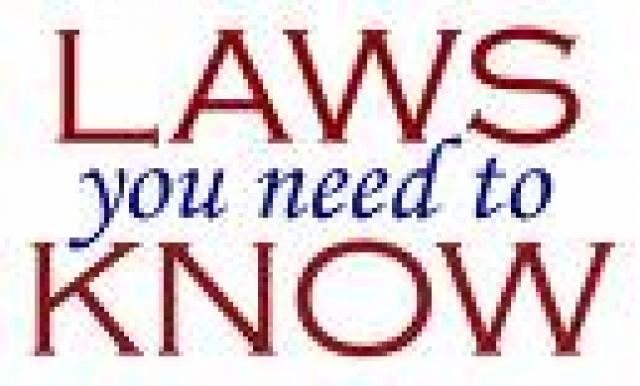






|
Please remember that to be in compliance with MiOSHA Regulations, your organization must have: · a specific written policy in each area An employer must start with an onsite analysis to determine which of these apply and need to be addressed. | |
| |
|
Aerial Lifts: Aerial lifts include the following types of vehicle-mounted aerial devices used to elevate personnel to job-sites above ground: Extensible boom platforms; Aerial ladders; articulating boom platforms; Vertical towers; and a combination of any such devices. Aerial equipment may be made of metal, wood, fiberglass reinforced plastic (FRP), or other material; may be powered or manually operated; and are deemed to be aerial lifts whether or not they are capable of rotating about a substantially vertical axis. (1926.453)
Ergonomics: OSHA will conduct inspections for ergonomic hazards and issue citations under the General Duty Clause and issue ergonomic hazard alert letters where appropriate. OSHA has a four-pronged comprehensive approach designed to quickly and effectively address musculoskeletal disorders (MSDs) in the workplace. (Ergonomics) Equipment and Machine Guarding: Methods shall be provided to protect the operator and other employees in the machine area from any hazards. The point of operation of machines, whose operation exposes an employee to injury, shall be guarded. The guarding device shall be in conformity with any appropriate standards therefore, or, in the absence of applicable specific standards, shall be so designed and constructed as to prevent the operator from having any part of his body in the danger zone during the operating cycle.(1910.212) Fall Protection: This section sets forth requirements for employers to provide fall protection systems. All fall protection required by this section shall conform to the criteria set forth in 1926.502 of this subpart. The employer shall determine if the walking/working surfaces on which its employees are to work have the strength and structural integrity to support employees safely. Employees shall be allowed to work on those surfaces only when the surfaces have the requisite strength and structural integrity. (1926.501) Fire Extinguisher / Fire Safety: OSHA requires employers to "furnish to each of his employees employment and a place of employment which are free from recognized hazards that are causing or are likely to cause death or serious physical harm to his employees". They also require employers to "comply with occupational safety and health standards promulgated under this Act". The employer must develop and implement a written fire safety plan that covers all the actions that employers and employees must take to ensure employee safety in the event of a fire. (1915.502) First Aid/CPR Training: First-aid and CPR training shall be conducted using the conventional methods of training such as lecture, demonstration, practical exercise and examination (both written and practical). The length of training must be sufficient to assure that trainees understand the concepts of first aid and can demonstrate their ability to perform the various procedures contained in the outline below.(1910.266 App B)
Hand and Portable Power Tools: OSHA standards require: each employer shall be responsible for the safe condition of tools and equipment used by employees, including tools and equipment which may be furnished by employees. Employers are also required to "furnish to each of his employees employment and a place of employment which are free from recognized hazards that are causing or are likely to cause death or serious physical harm to his employees". Employers are required to "comply with occupational safety and health standards promulgated under this Act". (1910.242) Hand Tool Safety: Reconstruction and modification; It shall be the responsibility of any person reconstructing, or modifying a mechanical power press to do so in accordance with paragraph (b) of this section. Hazards to personnel associated with broken or falling machine components. Machine components shall be designed, secured, or covered to minimize hazards caused by breakage, or loosening and falling or release of mechanical energy. (1910.217) Hazardous Waste / Concerns: Unless the employer can demonstrate that the operation does not involve employee exposure or the reasonable possibility for employee exposure to safely or health hazards: Clean-up operations required by a governmental body, whether Federal, state local or other involving hazardous substances that are conducted at uncontrolled hazardous waste sites; Emergency response operations for releases of, or substantial threats of releases of, hazardous substances without regard to the location of the hazard. (1910.120)
Hearing Conservation: Every year, approximately 30 million people in the United States are occupationally exposed to hazardous noise. Fortunately, the incidence of noise-induced hearing loss can be reduced or eliminated through the successful application of engineering controls and hearing conservation programs. (1910.95) Industrial Truck (Forklift): Each year, tens of thousands of injuries related to powered industrial trucks (PIT), or forklifts, occur in US workplaces. Unfortunately, most employee injuries and property damage can be attributed to lack of safe operating procedures, lack of safety-rule enforcement, and insufficient or inadequate training. This section contains safety requirements relating to fire protection, design, maintenance, and use of fork trucks, tractors, platform lift trucks, motorized hand trucks, and other specialized industrial trucks powered by electric motors or internal combustion engines. (1910.178)
Ladder Safety: OSHA regulations for ladder safety contain fall protection requirements for protecting an employee working on "walking/working surface". A walking/working surface is defined. Ladders shall be capable of supporting specific loads without failure. Ladders shall be inspected by a competent person for visible defects on a periodic basis and after any occurrence that could affect their safe use. (1926.1053) Lock Out - Tag Out: Addresses the practices and procedures necessary to disable machinery or equipment, thereby preventing the release of hazardous energy while employees perform servicing and maintenance activities. The standard outlines measures for controlling hazardous energies—electrical, mechanical, hydraulic, pneumatic, chemical, thermal, and other energy sources. (1910.147)
Permit Required Confined Space: A confined space has limited or restricted means for entry or exit, and it is not designed for continuous employee occupancy. OSHA requires employers to “furnish to each of his employees employment and a place of employment which are free from recognized hazards that are causing or are likely to cause death or serious physical harm to his employees". Section 5(a)(2) requires employers to "comply with occupational safety and health standards promulgated under this Act". Personal Protective Equipment: OSHA requires the use of personal protective equipment (PPE) to reduce employee exposure to hazards when engineering and administrative controls are not feasible or effective in reducing these exposures to acceptable levels. Employers are required to determine if PPE should be used to protect their workers. (1910.132) Respiratory: In the control of those occupational diseases caused by breathing contaminated air. The primary objective shall be to prevent atmospheric contamination. This shall be accomplished as far as feasible by accepted engineering control measures. When effective engineering controls are not feasible, or while they are being instituted, appropriate respirators shall be used pursuant to this section. A respirator shall be provided to each employee when such equipment is necessary to protect the health of such employee. The employer shall provide the respirators which are applicable and suitable for the purpose intended. The employer shall be responsible for the establishment and maintenance of a respiratory protection program, which shall include the requirements outlined in paragraph (c) of this section. The program shall cover each employee required by this section to use a respirator. (1910.134)
Right to Know / MSDS (Hazard Communication): Employees have both a need and a right to know the hazards and the identities of the chemicals they are exposed to when working. They also need to know what protective measures are available to prevent adverse effects from occurring. (1910.1200)
Safety Equipment / First Aid Equipment:First aid services and provisions for medical care shall be made available by the employer for every employee covered by these regulations. Regulations prescribing specific requirements for first aid, medical attention, and emergency facilities are contained in Subpart D of this part. (1926.23) Written Safety Policy / Program: Employers shall develop and implement a written safety and health program for their employees involved in hazardous waste operations. The program shall be designed to identify, evaluate, and control safety and health hazards, and provide for emergency response for hazardous waste operations. The organizational structure part of the program shall establish the specific chain of command and specify the overall responsibilities of supervisors and employees. The organizational structure shall be reviewed and updated as necessary to reflect the current status of waste site operations. The comprehensive work plan part of the program shall address the tasks and objectives of the site operations and the logistics and resources required to reach those tasks and objectives.. (R408.40114) Spray Finishing: This section applies to flammable and combustible finishing materials when applied as a spray by compressed air, airless or hydraulic atomization, steam, electrostatic methods, or by any other means in continuous or intermittent processes. The section also covers the application of combustible powders by powder spray guns, electrostatic powder spray guns, fluidized beds, or electrostatic fluidized beds. All spraying areas shall be provided with mechanical ventilation adequate to remove flammable vapors, mists, or powders to a safe location and to confine and control combustible residues so that life is not endangered. Mechanical ventilation shall be kept in operation at all times while spraying operations are being conducted and for a sufficient time thereafter to allow vapors from drying coated articles and drying finishing material residue to be exhausted (1910.107) | |
|
| |
| |
EMAIL MFAST |